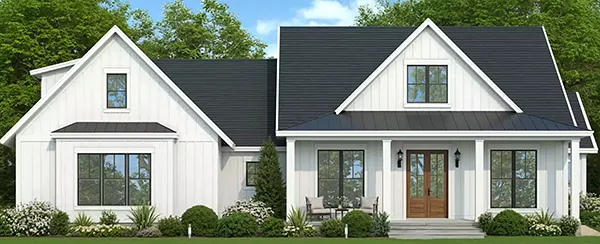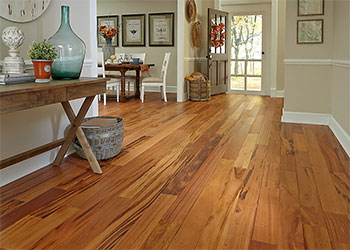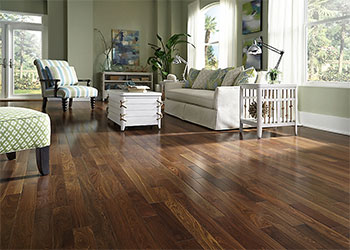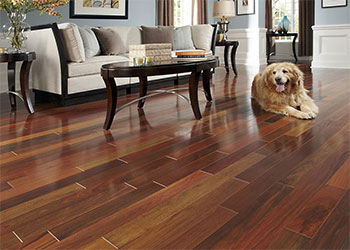Non-Traditional Hardwoods Amp Up Your Design
by Rachel Lyon, Editorial Director for The House Designers
Red oak is the most common hardwood flooring used in the United States, because it is one of the most abundant species available and comes reasonably priced as a result. It is also favored for its intrinsic characteristics, including its grain pattern that hides damage better than most and the fact that it easily takes stain to turn any color. But what if you want something a little more exciting? There are plenty more species available, both domestic and exotic, so you can make a statement with your floor. Whether you want a rich hue on which to build your interior design, or you want a high-contrast floor to take center stage on its own, here are some great hardwoods that stand out!
For a dense woodgrain with a range of striped red and brown hues, koa makes a beautiful floor. The
Bellawood Matte Brazilian Koa flooring from
Lumber Liquidators is a very low-maintenance example of the species, with an oil-rubbed look and low-gloss finish that resists wear and won’t show damage.
Choosing Richer Reds
To many people, the typical unfinished hardwood floor is light brown with a slight orange tint—the color of red oak before it is stained. The decision to go darker is made often, and deepening that tint into a stronger red is the natural choice. Why not look into wood species that offer the color you want all on their own? Depending on how bright or dark the red is, you can create a light and vibrant or subdued and sophisticated design to go with it. Even better, you won’t have to stain it again when it comes time to refinish.
You’ll find bolder natural red hues in a number of species, including koa, cherry, rosewood, bloodwood, and mahogany. These hardwoods are also darker overall, so they automatically imbue a more elegant look to a room. Consider the lighting in your home as you shop, because more sun and overhead light will bring out the color, and you wouldn’t want to settle on very dark flooring in an interior room. Each wood has its own unique characteristics that make it a favorite among those who insist on a richer red floor—it’s the ruddy base with dark contrasting stripes for koa, the color that deepens with age for cherry, the pink to orange glow of polished rosewood, the unmistakable brilliance of bloodwood, and the classic refinement of dark mahogany. No matter your preference, there is a redder hardwood that will enhance your home.
Bellawood Brazilian Ebony flooring combines extreme durability with rich dark brown colors to make it the prized amenity that it is. It is a fine hardwood that naturally resists wear and provides a strong base for the design of your choosing.
Naturally Dark Options
If you have a fondness for the deep look of a particularly dark floor, you’re not alone. Dark hardwoods offer a strong backdrop that will complement almost every design. So long as you choose a species with deep brown hues without underlying red pigments, it will support any design and colors in the room. Modern open floor plans love to use the contrast of dark floors; carrying them through connected living spaces doesn’t risk visually shrinking the perceived volume of the interior. You’ll notice that many older, traditional homes also feature very dark hardwood in their formally defined rooms. The key to success is keeping the walls light and having plenty of windows and artificial lighting to keep rooms from feeling too close. Colors will seem much more vibrant in this setup, and your design will pop as a result.
There are a handful of naturally dark hardwoods that have been favored for centuries—you can find very old homes that still show off a stately interior design including a dark floor. Black walnut is the only domestic species that can support this look, because the vast majority of American-grown woods are light. It automatically adds a warm ambiance with its chocolatey hues and straight graining. Of course, importing exotic species is necessary to fill the demand for darker hardwoods. Brazilian walnut is sought for its deep color and impressive hardiness, which is much greater than that of black walnut. And long a symbol of elegance and wealth, ebony makes for a stunning floor. Our appreciation for dark hardwoods was likely inspired by this coveted species.
Featuring a rare range of both tones and colors,
Bellawood Brazilian Walnut offers exceptional contrast that will breathe new life into an interior of any style. And as with any Bellawood flooring, it comes with a 100-year transferable warranty.
Investing in Contrast
If you want a floor that is dynamic and interesting on its own, take a look at high-contrast hardwoods. Striped, knotted, and mottled, you’ll find that there is plenty of variation within this category. A wide range of colors and levels of contrast—think light tan and nearly black versus a more subtle mix of browns—give you the chance to create a one-of-a-kind design. Depending on your goals, you can use these woods to instill a funky feel or a kind of unrestricted yet classic atmosphere. It’s all a matter of what you choose and how you use it!
Contrast manifests differently across species. For instance, you can find striping in koa and hickory, but these hardwoods have completely different visual effects on an interior. The red and dark brown colors in koa are bold and striking, while the mix of tans in hickory provide a gentler background that is easier to build on. Brazilian pecan shows off a large range of lights and darks in wider bands, so it immediately gets noticed and doesn’t come across as too refined. And perhaps in a class of its own, cypress features dark knots and swirling grains on a light background, making it one of the most unique floors you can get. Finally, there are species that show off a range of colors; Brazilian walnut and chestnut have undertones of red, yellow, and green, and laying planks with different hues side by side creates a floor that pops on its own.
There are so many hardwoods available to install in your home—you don’t have to stick with the common choice! Of course, you can always stain red oak to mimic the color of other species, but that can’t replicate woodgrain or contrast. No matter what kind of floor you’re looking for, let the immense selection available from Lumber Liquidators inspire you to do something great in your home. Find your nearest showroom to see the possibilities!



.png)
.png)




